Apparent Diurnal Variation
in Background Radiation
by John Walker
April 16, 2001
Updated: October 9th, 2017
 Since October 16th, 1998, I've
run an
Aware Electronics RM-80
radiation monitor pretty much continuously, connected to a serial port
on a 1992 vintage 486/50 machine. The RM-80 uses a 7313 pancake
Geiger-Müller tube. The tube is halogen quenched and has a minimum
dead time of 30 µS, with a mica window which allows alpha particles
to pass. The computer interface generates high voltage for the
tube from the Data Terminal Ready and Request to Send pins of the
serial port and toggles the state of the Ring Indicator line whenever
a count is detected. The serial port can be programmed to interrupt
on changes in the state of this signal, making it straightforward to
implement radiation monitoring in software. Tube sensitivity,
calibrated with Cesium-137 (137Cs), is 3.54 µR/hour
per count per minute.
Since October 16th, 1998, I've
run an
Aware Electronics RM-80
radiation monitor pretty much continuously, connected to a serial port
on a 1992 vintage 486/50 machine. The RM-80 uses a 7313 pancake
Geiger-Müller tube. The tube is halogen quenched and has a minimum
dead time of 30 µS, with a mica window which allows alpha particles
to pass. The computer interface generates high voltage for the
tube from the Data Terminal Ready and Request to Send pins of the
serial port and toggles the state of the Ring Indicator line whenever
a count is detected. The serial port can be programmed to interrupt
on changes in the state of this signal, making it straightforward to
implement radiation monitoring in software. Tube sensitivity,
calibrated with Cesium-137 (137Cs), is 3.54 µR/hour
per count per minute.
The second generation HotBits
generator uses an RM-80 detector
illuminated by a 5 microcurie 137Cs check source.
I decided to attach the HotBits spare detector to a PC
and let it run as a background radiation monitor, as much as
anything to let the detector run for a while to guard against
“infant mortality” in any of its components, should it have
to take over for the in-service detector. Aware Electronics
supplies the detector with a DOS driver program called
AW-SRAD, which I used to log the number of
counts per minute, logging the collected data to files
in CSV format.
Database Coverage
Here's a plot that shows the extent of coverage by month
over the period I monitored background radiation. The month
of May, for example, has just about one year's complete data
(this doesn't necessarily mean all of May for one year—it
might be half of May in 1999 and half in 2000, for example).
November has the greatest coverage, in excess of 2.5 years
of data. The summer months have the least coverage due to
vacations and other circumstances which caused me to shut
down the machine connected to the detector. Since we're
examining only diurnal variations—change in flux within a
day—the uneven coverage over the months shouldn't be a
problem. If we wanted to explore, for example, whether any
diurnal variation we detected varied from month to month, it
would be best to extract a subset of the data weighted
equally by month, ideally with full coverage of each day of
the solar year even though the days may be taken from
different years.
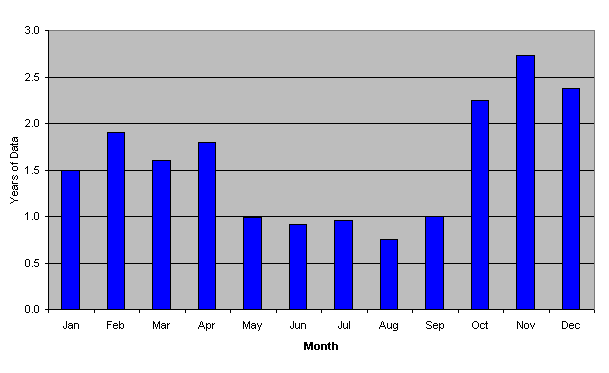
Counts per Minute Histogram
The first obvious step in reducing the data is to plot a histogram
showing the distribution of counts per minute; the vertical axis is
the number of minutes in the database in which the number of counts on
the horizontal axis were recorded. The histogram table is reproduced
in the bar at the right and plotted below.
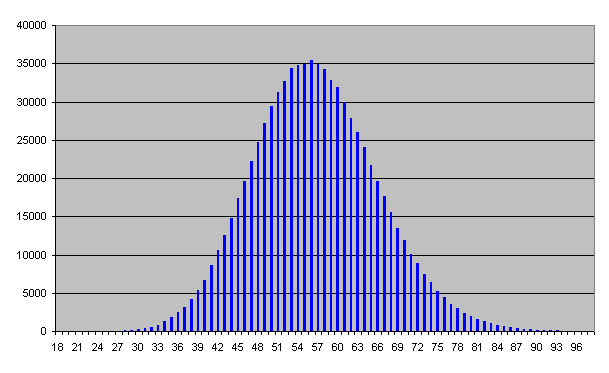
At first glance, this looks like the Gaussian “bell curve”
you'd expect for a random process. At second glance, however,
it doesn't…note that the “tail” on the right hand
side, corresponding to larger numbers of counts per minutes
appears distinctly longer and “fatter” than the tail on the
left side. Still, let's proceed for the moment on the assumption
that we do have a Gaussian distribution and calculate the
mean and standard deviation from the data set. Crunching the
numbers, we find a mean value of 56.65 counts per minute with
a standard deviation of 9.31. We can then plot this Gaussian
(normal) distribution as a red line superimposed on the histogram
of experimental results.
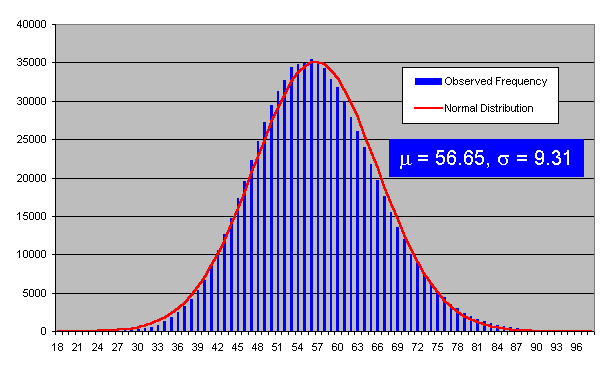
This makes it even more apparent that there's something
happening which isn't “perfectly normal”. Note how the excess
on the high end of the histogram pulls the best-fit normal
distribution to the right of the actual data distribution, with
the histogram bars to the left of the mean consistently exceeding the
value of the normal curve and those to the right falling
below.
You might be inclined to wonder just how closely we should
expect experimental results like these to approximate
a normal distribution. Could the observed deviation be nothing
more than a statistical fluke? No…compare the fit of the
background radiation histogram above with the the plot below of a data set
of comparable size collected using the same detector but, instead of
monitoring background radiation in counts per minute, measuring
counts per second with the detector illuminated by the HotBits
Cesium-137 source. Although this data set necessarily includes background
radiation as well as counts due to the radiation source, with
about 2000 counts per second from the 137Cs source, the roughly
one count per second from background radiation has a negligible influence
on the results.
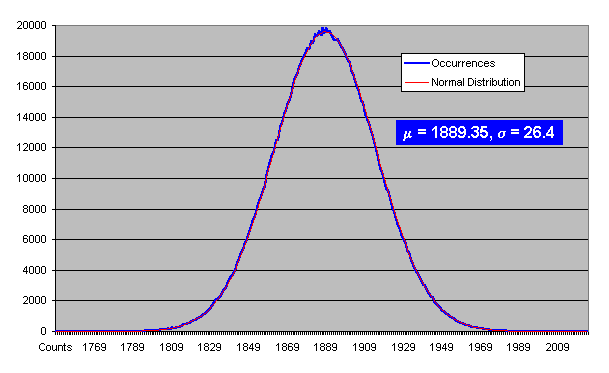
In the radiation source data set we see an essentially perfect fit
of the expected normal distribution to the experimental data. This
makes it quite clear that there's something curious going on with
the background radiation data. But what?
The Two Population Hypothesis
One way we might end up with the kind of asymmetrical distribution
we observe for the background radiation is if the radiation flux
we're measuring is composed of two separate components, or
populations, each individually normally distributed,
but with different peak value, mean, and standard deviation.
Suppose, for example, that the background radiation the
detector measures is the sum of that due to decay of
heavy elements (principally thorium and daughter nuclides)
in the immediate vicinity (the earth beneath the detector and
the structure of the building in which it is located) and a
less intense cosmic ray flux which occurs in sporadic
bursts with a greater mean value than the terrestrial flux.
(At this point I'm simply suggesting these sources to illustrate
how the background radiation might be composed of two (or more)
separate populations with different statistics; I'm not
identifying them as the actual components.)
Here's a “toy model” which illustrates how this might work.
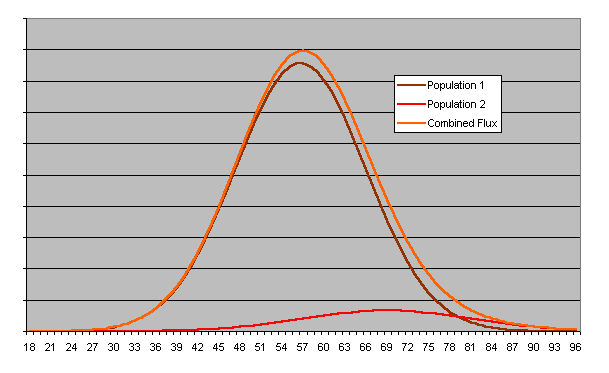
Let the brown curve labeled “Population 1” represent the
terrestrial component of background radiation. It has a
mean value of around 58 counts per minute and exhibits a
precisely Gaussian distribution with total flux equal to
the area under the brown Population 1 curve. We take the
red “Population 2” curve to represent the supposed cosmic
ray flux. This also has a normal distribution, but with
a mean value of about 70 counts per minute, a greater standard
deviation (resulting in a broader distribution curve), and a
total flux only about one tenth that of Population 1.
Since counts resulting from the two populations cannot be
distinguished by our simple detector, what we observe is
the sum of the two populations, shown as the orange “Combined
Flux” curve. Note the strong resemblance between this curve
and the histogram plot from the detector; while Population
1 dominates the result, the contribution of Population 2
lifts and extends the high end of the combined distribution,
precisely as we observed in the experimental data set.
Radiation by Local Solar Time
Next I tried binning the results hourly by local solar time.
The following chart shows the results, plotted in terms of
average background radiation flux in micro-Roentgens per
hour. (The average background radiation of
16.2 µR/hr—142 mR per year—may
seem high, but my detector is located at an
altitude of 800 metres above sea level. Both the soft and
hard [primarily muon] components of cosmic rays are absorbed
by the atmosphere, so at a higher altitude more they are
more intense. At sea level, cosmic rays contribute about
30 mR/year, but at the 10 km altitude commercial jet aircraft
fly, cosmic radiation accounts for about 2000 mR/year; more
than 60 times as intense.) When I plotted the hourly local
time averages, I obtained the following result.
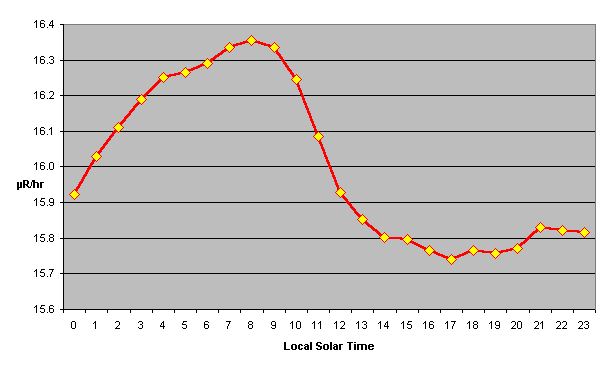
I've read about variations in cosmic ray flux varying
with latitude, in Easterly and Westerly incidence,
the solar cycle, and changes in the geomagnetic
field, without a mention of a diurnal cycle, yet this
plot appears to show a sinusoidal variation, with
a magnitude variation between the highest three-hour
period and the lowest of almost 6% of the mean
value and, further, the trough in the curve seems to
be about 12 hours from the peak.
To explore whether this might be nothing
but an artifact or statistical fluctuation, I then re-binned
the same data minute by minute, resulting in the following plot,
in which the blue curve is the raw minute-binned data and the
red curve is the same data filtered by an
exponentially smoothed
moving average with a smoothing factor of 0.9.
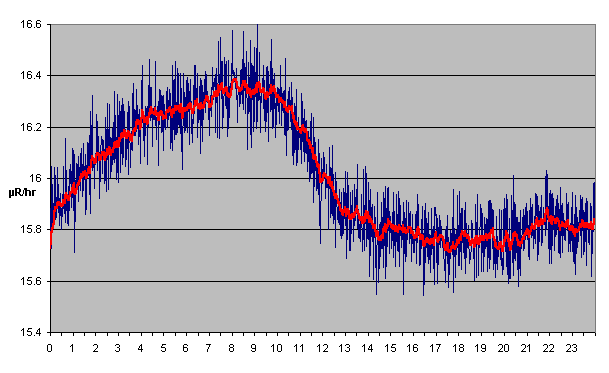
| Randomly selected data subset |
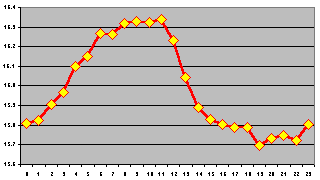
|
Well, it still looks credibly sinusoidal, with the maximum and
minimum at about the same point. As we all know, the human eye and
brain are extraordinarily adept at seeing patterns in random data. So
let's try another test frequently applied as a reality check when
apparently significant results appear in a data set. The chart at the left
was created by randomly selecting 25% of the points appearing in the
complete data set and plotting them hour by hour. We find that the
selection has little effect on the shape of the curve or the location
of its maximum and minimum.
| Outliers removed. |
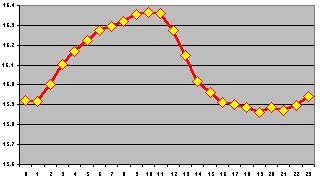
|
Next, I decided to explore whether the apparent sinusoidal variation
might disappear if I discarded outlying values, which might conceivably
vary differently in time than those which make up the bulk of the
database. I pruned the bell curve at one standard deviation,
then used the remaining data to prepare the plot at the left. As you
can see, the case for a sinusoidal variation is eroded
somewhat, but the general shape, magnitude, and location of extrema
is conserved.
Outliers and Populations
The fact that removing the outlying values reduced the diurnal
variation in the above plot suggests that we may indeed have
two populations contributing to the observed flux, with the
population responsible for the outlying values containing more
diurnal variation than that near the mean. To investigate this
further, I passed the data set through a variety of filters and
prepared the following plot.
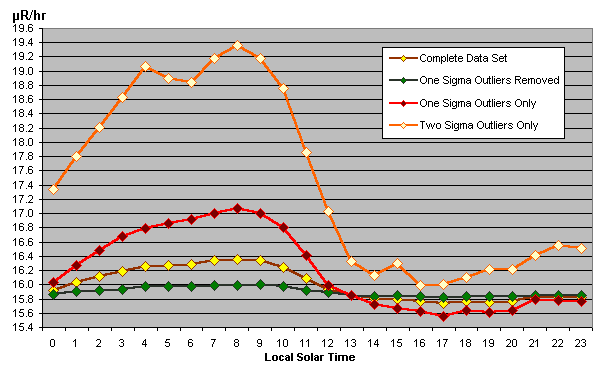
In the Stars?
Finally, I decided to plot the average radiation flux
against local sidereal time. Sidereal time tracks the
position of the distant stars as viewed from a given point
on the Earth. At the same sidereal time, the same celestial
objects (external to the solar system) will cross the
celestial meridian above a given place on the Earth.
Because the viewpoint of the Earth shifts as it orbits the
Sun, the sidereal day (time between successive meridian
crossings of a given star) is about 4 minutes shorter than
the solar day (mean time between solar meridian crossings).
Correlation with the sidereal period is powerful evidence
for a distant source as the cause of a given effect. For
example, it was correlation with the sidereal period which
provided early radio astronomers evidence the centre of the
galaxy and Crab Nebula were celestial sources of the noise
they were monitoring. Here's a plot of average radiation
flux by sidereal time.
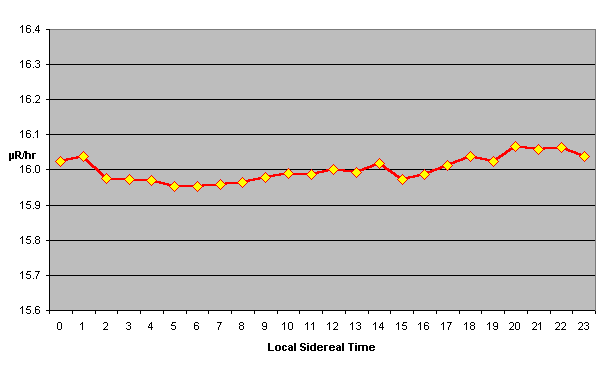
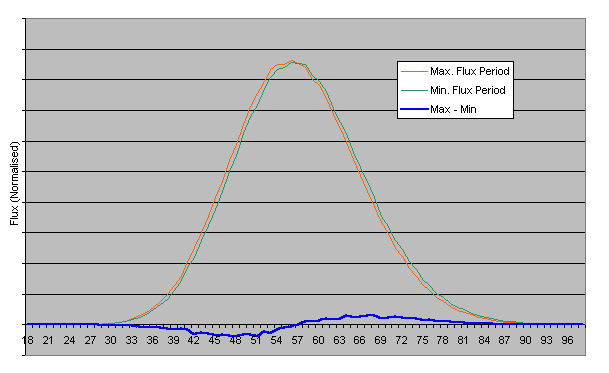
What's Going On Here?
Darned if I know! The floor is open to inference and speculation.
First of all, I think it's reasonable to assume that any
diurnal variation, should such exist, is due to cosmic
rays. The balance of background radiation is primarily due to
thorium, radon, and daughter nuclides in the local environment.
Where I live, in the Jura mountains of Switzerland, subterranean
rocks are almost entirely limestone, which has little or no
direct radioactivity (as opposed to, for example, granite), nor
radon precursors. In such an environment, it's hard to imagine
a background radiation component other than cosmic rays
which would vary on a daily basis. (This would not be
the case, for example, in a house with a
radon problem, where you would expect to see a decrease when doors
and windows were opened during the day.)
If the effect is genuine, and the cause is cosmic ray flux,
what are possible causes? The two which pop to mind are
atmospheric density and the geomagnetic field. During the day,
as the Sun heats the atmosphere, it expands. If you're at
sea level, the total absorption cross section remains the same,
but the altitude at which the primary cosmic ray first interacts
with an atmospheric atom may increase. Further, an increase in
atmospheric temperature may change the scale height of of
the atmosphere, which would perturb values measured at various
altitudes above sea level. We could explore temperature dependence
by comparing average background radiation in summer and winter
months.
Let's move on to the geomagnetic field. It's well documented
that the Earth's magnetic field and its interaction with the
Sun's create measurable changes in cosmic ray incidence, since
the proton and heavy ion component of primary particles is charged
and follows magnetic field lines. As any radio amateur or listener
to AM radio in the 1950s knows, the ionosphere changes dramatically
at night, allowing “skip propagation” of medium- and high-frequency
signals far beyond the horizon. Perhaps this effect also
modifies the geomagnetic field, affecting the number of charged
cosmic rays incident at a given location.
If there is a diurnal effect, why on Earth should it peak around
07:00 local time? Beats me.
References
Clay, Roger, and Bruce Dawson.
Cosmic Bullets.
Reading, MA: Addison-Wesley, 1997.
ISBN 978-0-7382-0139-9.
Wheeler, John Archibald, and Kenneth Ford.
Geons, Black Holes, and Quantum Foam:
A Life in Physics.
New York: W.W. Norton, 1998.
ISBN 978-0-393-31991-0.
Download Raw Data and Analysis Programs
If you'd like to perform your own investigations of this data set, you can
download the data and programs used in
preparing this page. The 2.8 Mb Zipped archive contains the raw data in
rad5.csv and a variety of Perl programs which were used to
process it in various ways. There is no documentation and these
programs are utterly unsupported: you're entirely on your own.
by John Walker
 Since October 16th, 1998, I've
run an
Aware Electronics RM-80
radiation monitor pretty much continuously, connected to a serial port
on a 1992 vintage 486/50 machine. The RM-80 uses a 7313 pancake
Geiger-Müller tube. The tube is halogen quenched and has a minimum
dead time of 30 µS, with a mica window which allows alpha particles
to pass. The computer interface generates high voltage for the
tube from the Data Terminal Ready and Request to Send pins of the
serial port and toggles the state of the Ring Indicator line whenever
a count is detected. The serial port can be programmed to interrupt
on changes in the state of this signal, making it straightforward to
implement radiation monitoring in software. Tube sensitivity,
calibrated with Cesium-137 (137Cs), is 3.54 µR/hour
per count per minute.
Since October 16th, 1998, I've
run an
Aware Electronics RM-80
radiation monitor pretty much continuously, connected to a serial port
on a 1992 vintage 486/50 machine. The RM-80 uses a 7313 pancake
Geiger-Müller tube. The tube is halogen quenched and has a minimum
dead time of 30 µS, with a mica window which allows alpha particles
to pass. The computer interface generates high voltage for the
tube from the Data Terminal Ready and Request to Send pins of the
serial port and toggles the state of the Ring Indicator line whenever
a count is detected. The serial port can be programmed to interrupt
on changes in the state of this signal, making it straightforward to
implement radiation monitoring in software. Tube sensitivity,
calibrated with Cesium-137 (137Cs), is 3.54 µR/hour
per count per minute.











